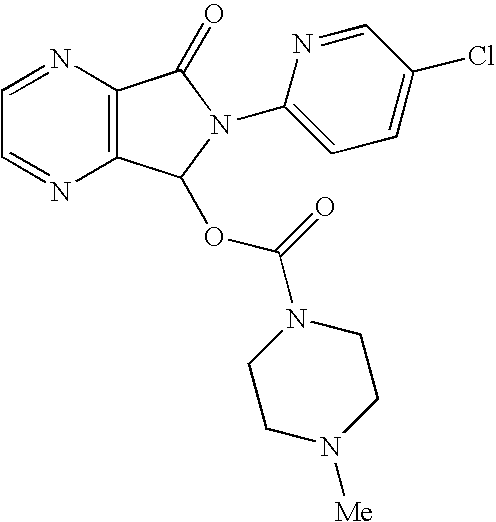Methods for preparing eszopiclone crystalline form a, substantially pure eszopiclone and optically enriched eszopiclone
- Summary
- Abstract
- Description
- Claims
- Application Information
AI Technical Summary
Benefits of technology
Problems solved by technology
Method used
Image
Examples
example 1
Preparation of Eszopiclone Form A from Ethyl Acetate [Comparative Example]
[0065] To eszopiclone free base (1 g) was added ethyl acetate (AR grade) (20 ml) and the slurry was heated to reflux. At reflux, an additional 10 ml of ethyl acetate were added to complete dissolution of the solid. Heating was stopped and the solution was cooled in ice-acetone bath to a temperature of about −10° C. in 15 min. Precipitation started at 60° C. The mixture was stirred at about −10° C. for 1 h. The solid was filtered, washed with 2 ml EtOAc and dried in a vacuum oven at 60° C. to yield eszopiclone Form A. Yield 80%.
example 2
Preparation of Eszopiclone Form A from MIBK
[0066] To eszopiclone free base (1.5 gr) was added MIBK (CP grade) (6 ml) and the obtained slurry was heated to reflux. During heating an additional 6 ml of MIBK were added. At reflux additional solvent (9 ml) was added to induce complete dissolution of the solid. Heating was stopped and the solution was cooled to the room temperature. Precipitation started at 80° C. After this the mixture was cooled to 26° C. in 45 min. and stirred at room temperature for 2 h. The solid was filtered, washed with 2 ml MIBK and dried in vacuum oven at 65° C. The wet material was Eszopiclone Form A. Yield 80%. (Chemical Purity 99.96% by HPLC).
example 3
Preparation of Eszopiclone Form A from N-Butanol
[0067] To eszopiclone free base (1.5 gr.) was added n-BuOH(CP grade) (6 ml) and the obtained slurry was heated to reflux. At reflux (114° C.), additional 4 ml of n-BuOH were added to slurry till full dissolution of the solid. Then heating was stopped and solution was cooled to the room temperature. Precipitation of solid started at 100° C. The mixture was cooled to 29° C. in about 40 min. and then stirred at room temperature (26° C.-29° C.) for 1 h. The solid was filtered, washed with 3 ml n-BuOH and dried in a vacuum oven at 65° C. and 7 mm Hg. Yield 90% (Chemical Purity 100% by HPLC).
PUM
 Login to View More
Login to View More Abstract
Description
Claims
Application Information
 Login to View More
Login to View More - R&D
- Intellectual Property
- Life Sciences
- Materials
- Tech Scout
- Unparalleled Data Quality
- Higher Quality Content
- 60% Fewer Hallucinations
Browse by: Latest US Patents, China's latest patents, Technical Efficacy Thesaurus, Application Domain, Technology Topic, Popular Technical Reports.
© 2025 PatSnap. All rights reserved.Legal|Privacy policy|Modern Slavery Act Transparency Statement|Sitemap|About US| Contact US: help@patsnap.com


